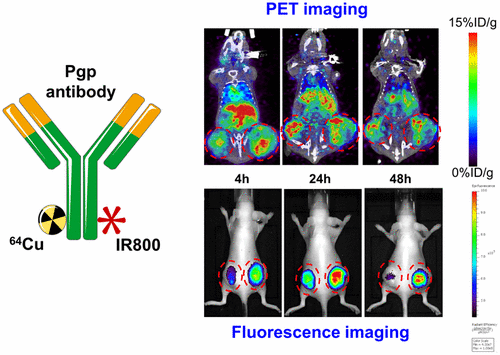当前位置:
X-MOL 学术
›
Mol. Pharmaceutics
›
论文详情
Our official English website, www.x-mol.net, welcomes your
feedback! (Note: you will need to create a separate account there.)
Molecular Imaging of P-glycoprotein in Chemoresistant Tumors Using a Dual-Modality PET/Fluorescence Probe
Molecular Pharmaceutics ( IF 4.5 ) Pub Date : 2017-08-30 00:00:00 , DOI: 10.1021/acs.molpharmaceut.7b00420 Mengzhe Wang 1 , Chengqiong Mao 2, 3 , Hui Wang 1 , Xueying Ling 1 , Zhanhong Wu 1 , Zibo Li 1 , Xin Ming 2, 3
Molecular Pharmaceutics ( IF 4.5 ) Pub Date : 2017-08-30 00:00:00 , DOI: 10.1021/acs.molpharmaceut.7b00420 Mengzhe Wang 1 , Chengqiong Mao 2, 3 , Hui Wang 1 , Xueying Ling 1 , Zhanhong Wu 1 , Zibo Li 1 , Xin Ming 2, 3
Affiliation

|
Overexpression of P-glycoprotein (Pgp) has been considered a primary cause for multidrug resistance in a variety of cancers for three decades. However, clinical translation of Pgp targeted therapeutics has been hindered by lack of patient preselection based on the Pgp presence in tumors. We aim to develop a molecularly targeted probe for imaging tumoral Pgp in vivo with positron emission tomography (PET) and fluorescence, and to provide a tool for preselecting the patients with tumoral Pgp expression. Thus, a Pgp monoclonal antibody 15D3 was chemically modified with IRDye800 (IR800) and DOTA chelator. The specificity of the antibody conjugates DOTA-Pab-IR800 was verified in Pgp-expressing 3T3-MDR1 and control 3T3 cells. After radiolabeling with 64Cu, the probe was applied in small animal PET imaging of Pgp in a mouse xenograft model of NCI/ADR-Res cells, which are chemoresistant through overexpression of Pgp. Quantification analysis of the PET images demonstrated that the tumor uptake of the radioactive probe was 9.9 ± 1.4, 12.1 ± 1.2, and 10.5 ± 1.0%ID/g at 4, 24, and 48 h post injection. The tumor-to-muscle ratio was 20.9 at 48 h post injection based on biodistribution studies. Fluorescence imaging was performed following PET experiments, and it demonstrated excellent tumor accumulation of this dual-modality probe in the NCI/ADR-Res tumors. Further, an image-guided surgery was successfully performed using the fluorescence modality of the probe, demonstrating potential utility of this probe in image-guided surgical removal of Pgp-positive drug resistant tumors in the patients. In conclusion, this study clearly demonstrated that the Pgp-targeted antibody probe, 64Cu-DOTA-Pab-IR800, could provide a promising diagnosis tool for detection of Pgp-expressing tumors in vivo.
中文翻译:

使用双模式PET /荧光探针对化学耐药性肿瘤中P-糖蛋白的分子成像
P-糖蛋白(Pgp)的过表达在三十年以来一直被认为是多种癌症中多药耐药性的主要原因。但是,由于缺乏基于肿瘤中Pgp存在的患者预选,阻碍了Pgp靶向治疗剂的临床翻译。我们旨在开发一种分子靶向探针,用于通过正电子发射断层扫描(PET)和荧光对体内的肿瘤Pgp进行成像,并为预选具有肿瘤Pgp表达的患者提供一种工具。因此,用IRDye800(IR800)和DOTA螯合剂对Pgp单克隆抗体15D3进行了化学修饰。在表达Pgp的3T3-MDR1和对照3T3细胞中证实了抗体缀合物DOTA-Pab-IR800的特异性。用64进行放射性标记后Cu,该探针用于NCI / ADR-Res细胞小鼠异种移植模型中Pgp的小动物PET成像中,该模型通过Pgp的过表达而具有化学抗性。PET图像的定量分析表明,在注射后4、24和48 h,放射性探针的肿瘤吸收率为9.9±1.4、12.1±1.2和10.5±1.0%ID / g。根据生物分布研究,注射后48小时,肿瘤与肌肉的比例为20.9。在PET实验之后进行了荧光成像,结果表明,这种双峰探针在NCI / ADR-Res肿瘤中具有出色的肿瘤蓄积性。此外,使用探针的荧光形式成功地进行了图像引导的手术,证明了该探针在患者的Pgp阳性耐药肿瘤的图像引导手术中的潜在用途。64 Cu-DOTA-Pab-IR800可为体内检测表达Pgp的肿瘤提供有希望的诊断工具。
更新日期:2017-08-31
中文翻译:

使用双模式PET /荧光探针对化学耐药性肿瘤中P-糖蛋白的分子成像
P-糖蛋白(Pgp)的过表达在三十年以来一直被认为是多种癌症中多药耐药性的主要原因。但是,由于缺乏基于肿瘤中Pgp存在的患者预选,阻碍了Pgp靶向治疗剂的临床翻译。我们旨在开发一种分子靶向探针,用于通过正电子发射断层扫描(PET)和荧光对体内的肿瘤Pgp进行成像,并为预选具有肿瘤Pgp表达的患者提供一种工具。因此,用IRDye800(IR800)和DOTA螯合剂对Pgp单克隆抗体15D3进行了化学修饰。在表达Pgp的3T3-MDR1和对照3T3细胞中证实了抗体缀合物DOTA-Pab-IR800的特异性。用64进行放射性标记后Cu,该探针用于NCI / ADR-Res细胞小鼠异种移植模型中Pgp的小动物PET成像中,该模型通过Pgp的过表达而具有化学抗性。PET图像的定量分析表明,在注射后4、24和48 h,放射性探针的肿瘤吸收率为9.9±1.4、12.1±1.2和10.5±1.0%ID / g。根据生物分布研究,注射后48小时,肿瘤与肌肉的比例为20.9。在PET实验之后进行了荧光成像,结果表明,这种双峰探针在NCI / ADR-Res肿瘤中具有出色的肿瘤蓄积性。此外,使用探针的荧光形式成功地进行了图像引导的手术,证明了该探针在患者的Pgp阳性耐药肿瘤的图像引导手术中的潜在用途。64 Cu-DOTA-Pab-IR800可为体内检测表达Pgp的肿瘤提供有希望的诊断工具。











































 京公网安备 11010802027423号
京公网安备 11010802027423号